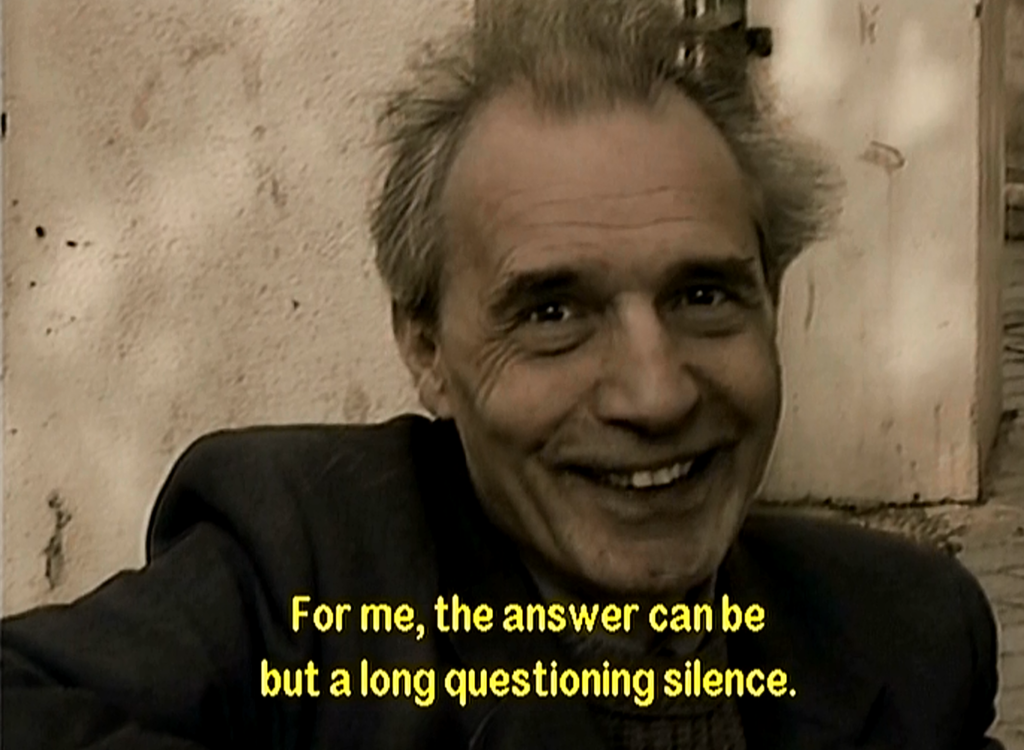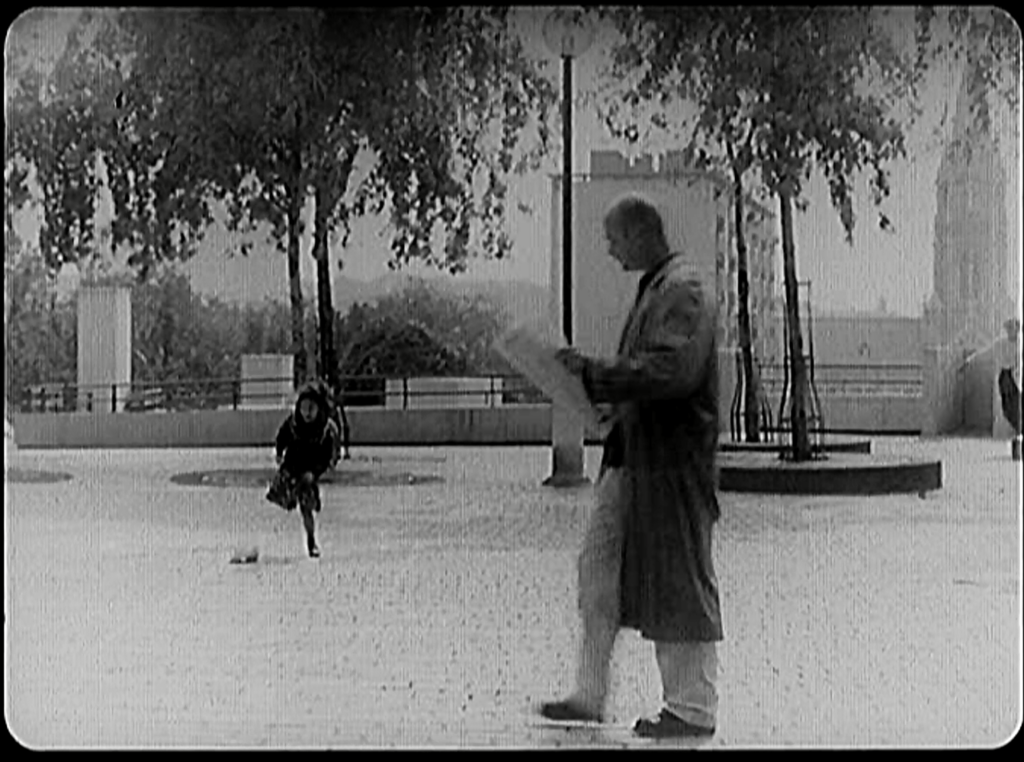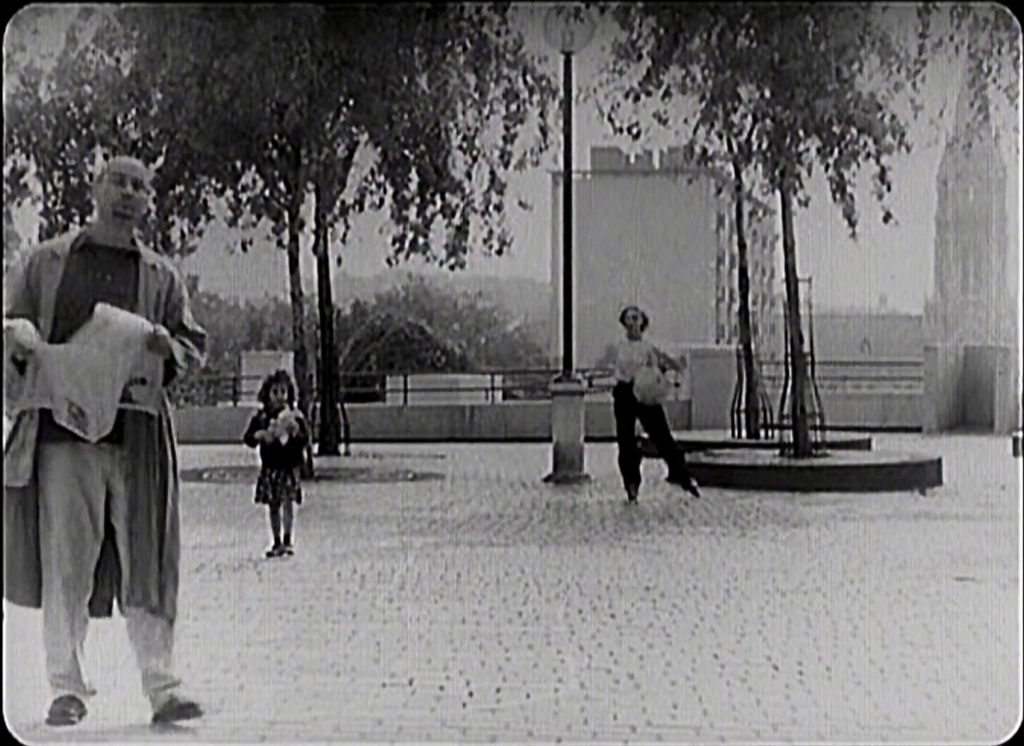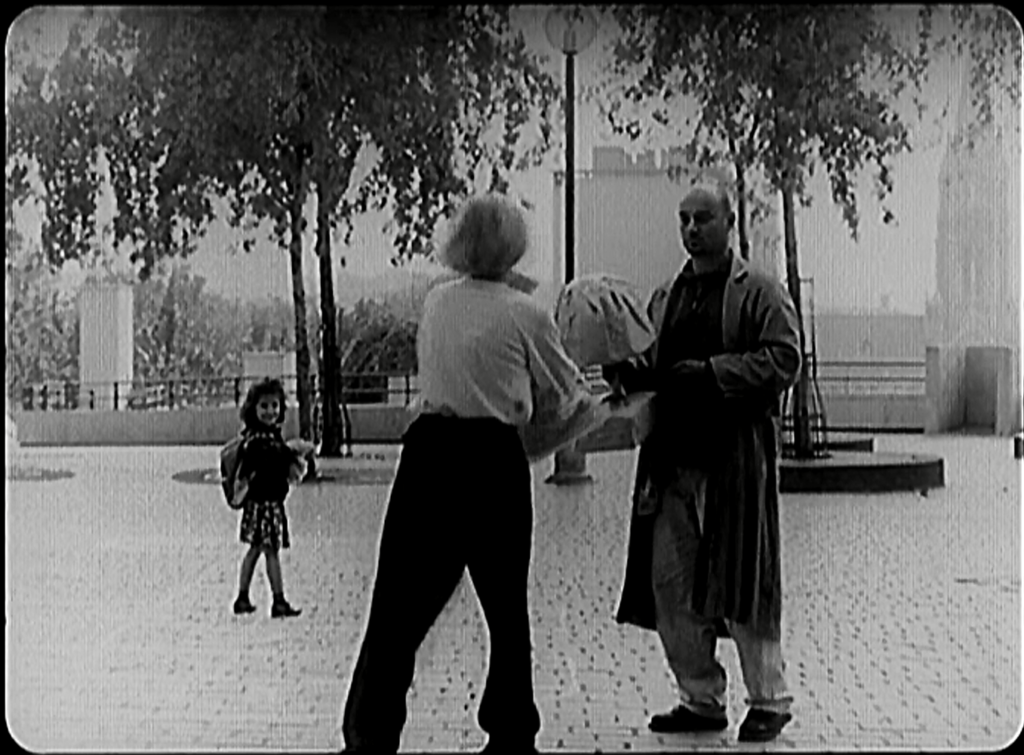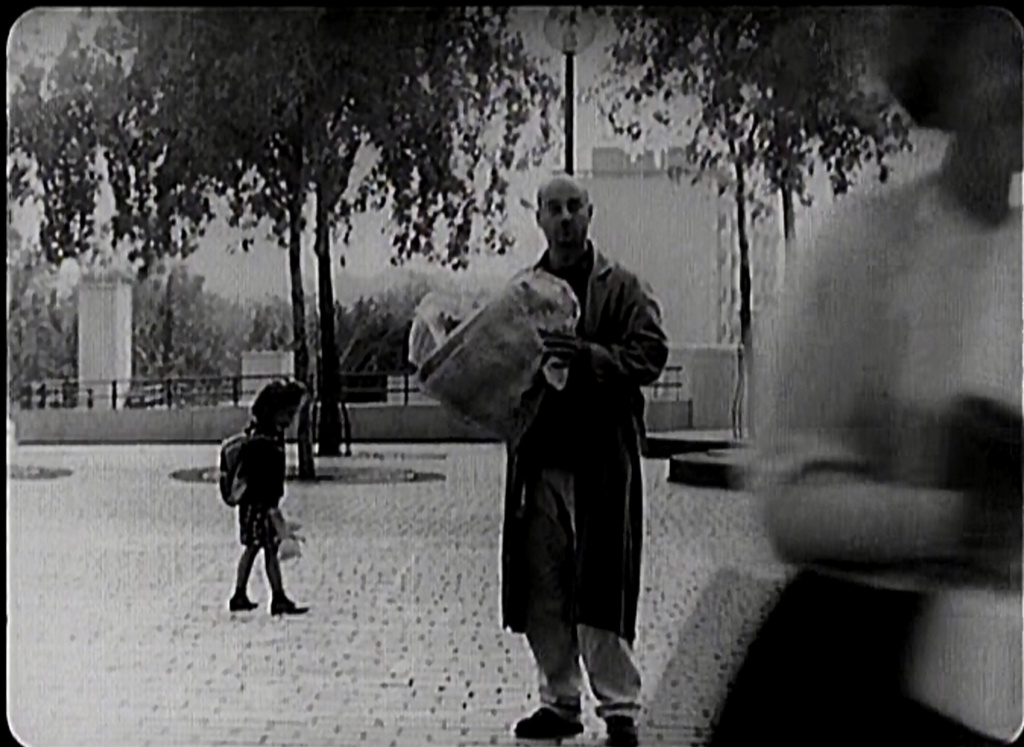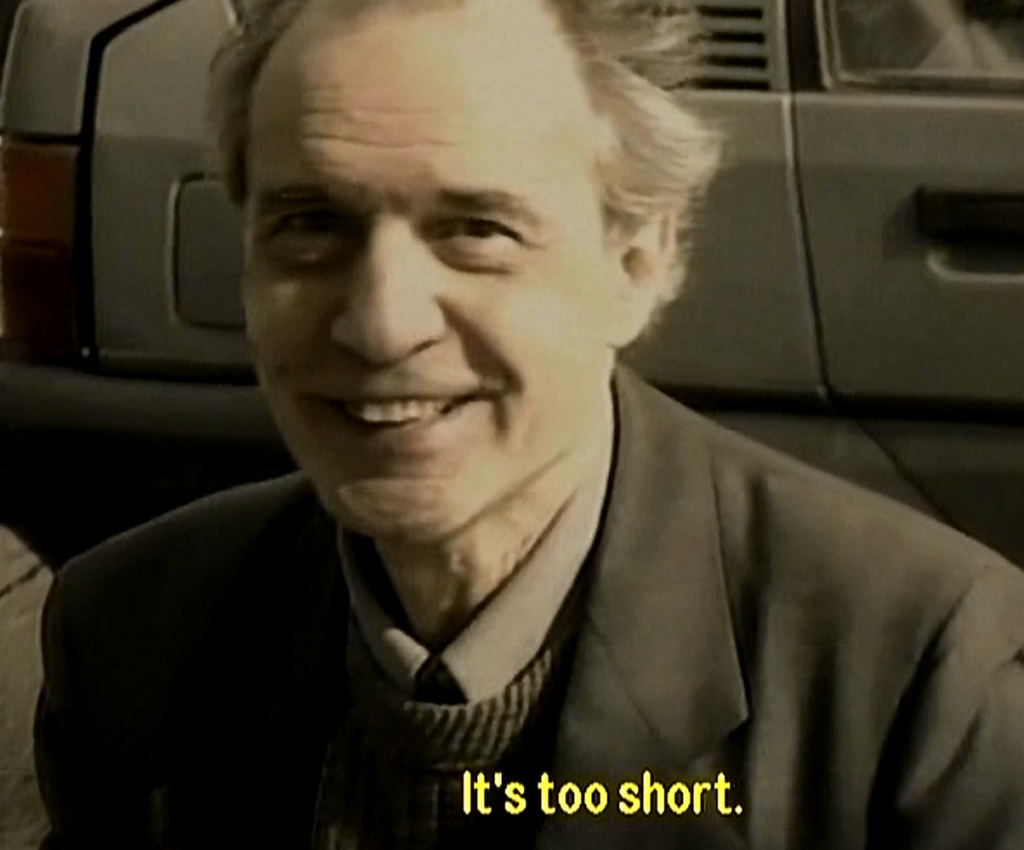Jacques Rivette’s Homage to Louis Lumière: To Pastiche and Beyond
Richard Neupert
It seems almost perverse that the team behind the 1995 Lumière et Compagnie, in which forty international directors each prepare and shoot a fifty-second motion picture with an original Cinématographe camera, should have invited Jacques Rivette to participate. Rivette is not known for his brevity, much less concise concepts or vision. His motion pictures are usually long, sprawling affairs with elaborate dialogue featuring complex, meandering characters interacting within a world full of unanswered and unanswerable questions. Narrative information arrives gradually in sometimes contradictory bits and pieces in Rivette’s worlds. None of these traits seem particularly promising for making a Lumière-style short. And yet, Rivette’s 50-second Une aventure de Ninon (1895) provides a condensed look into a few of Rivette’s core ideas on cinema and helps point out several of his key auteur traits. This short experiment is also his most perfect and loving homage to cinema history, and, in the end, Une aventure de Ninon becomes a rare synthesis and pastiche: It is simultaneously a Jacques Rivette film and a Lumière film.[1]
For the commemoration of the 100th anniversary of the Cinématographe’s first public screening in 1995, Philippe Poulet of the Lumière Musée du Cinéma in Lyon proposed inviting a wide range of contemporary international filmmakers to shoot their own 50-second motion pictures using an original Cinématographe camera, complete with authentic, two sprocket-hole film stock. The directors were limited by a narrow time-line and a rather rigid set of guidelines. Each installment was filmed by Poulet or his colleague Didier Ferry. Among the wide range of directors able to join the production were Spike Lee, Idrissa Ouedraogo, Zhang Yimou, and Wim Wenders. Rivette was one of a cluster of French directors, including Nadine Tringtignant, Patrice Leconte, Claude Lelouch, and Claude Miller.
The project resulted in an omnibus, held together, as Variety put it, by the “narrative glue” of video portraits and fragments of interviews on location with the directors. Variety points out that Sarah Moon produced these sections, asking questions, including “‘Why do you make movies?’ A surprising number of participants are at a loss to articulate why they film, with Jacques Rivette literally speechless.”[2] However, after shrugging off the question with a puzzled look, he does add, “The only response can be a long questioning silence from me.” Yet, within Lumière and Company Rivette, who was one of the most passionate historians among the New Wave generation, does explain why he was anxious to take part in this nostalgic endeavor: “I have never seen a [Cinématographe] in action and wanted to see it working, and especially as a director.” He then adds, “or as someone pretending to be a director,” with his trademark wry smile. Clearly, directing a 50-second short in several limited takes with a Lumière museum camera operator at the controls changed Rivette’s relations with the camera; he is directing to and for the apparatus in a manner alien to his usual routines. Every second counts, and while Rivette may technically act as director, the operator Philippe Poulet is running the shoot, controlling what Rivette calls “la petite boîte en bois,” Lumière’s magical little wooden box.[3]
Beyond his fascination with cinema’s history and criticism, Rivette has repeatedly revealed his respect and even fascination for the Lumière films and their Cinématographe. As a critic at Cahiers du Cinéma, his 1954 article, “The Age of Metteurs en scène,” on the potential perils of widescreen, includes the statement that, “If certain documentary images are superior, it is because it is in the logic of things that the genius of the machine bursts out in advance of the creators’ genius. Lumière will always have more charm than Méliès.”[4] In fact, the opening of Rivette’s debut feature film, Paris Belongs to Us (Paris nous appartient, 1961), begins with a pastiche of Lumière films. Early Lumière films presented several views from a moving train arriving in a city, including Constantinople and Lyon. Rivette begins his movie with several shots from a speeding train window revealing the countryside and then industrial suburbs sliding past before eventually pulling into the Gare d’Austerlitz. This two-minute series of five shots, with cuts hidden by dark transitions, provides no reverse shot to reveal whether these images represent anyone’s point of view, and only later might a spectator retroactively assign them to the protagonist, student Anne Goupil (Betty Schneider). Rather than beginning Paris Belongs to Us by inserting a character into a narrative space, Rivette offers objective glimpses of landscapes, transformed by the camera’s motion. He begins with these dynamic attractions before introducing the story of Anne, stuck in the grim maze of Paris and insurmountable intrigues. Even his praise of neorealist directors such as Roberto Rossellini was anchored in his respect that they showed rather than told the stories of his characters.[5]
When Rivette finally does get a chance to shoot à la Lumière, he combines his respect for cinema history with his fascination with performance. For him, “all films are theater” and he privileges spontaneity. Une Aventure de Ninon, shot in the fall of 1995, even builds loosely from Rivette’s previous film, Haut, bas, fragile (Up, Down, Fragile) which had been released in the spring of 1995. Ninon was Nathalie Richard’s character, who is a free spirit and petty criminal, temporarily working as an unconventional delivery person, sometimes zooming off on a scooter, sometimes on roller skates. As Mary Wiles points out, much of Ninon’s “easy movement through Paris back streets on roller blades” continues the carefree mobility of her occasional animated dance routines.[6] Ninon is a tireless whirlwind on screen. For Une aventure de Ninon, she returns, roller blading quickly through the space before disappearing for some new adventure. It is as if Rivette has not gotten enough of Nathalie Richard’s contagious energy from Haut, bas, fragile. For the Lumière short, she embodies a cartoon-like figure evoking a complex mix of emotional cues.
Une aventure de Ninon is staged in the parc de Belleville, in northeast Paris. The shot opens, like so many Lumières, by presenting a public space. A few branches move in the breeze within the briefly empty place before a young girl nearly catapults into the shot from the left, notices a hop-scotch game chalked out on the bricks, and begins to jump into the squares, tossing her stuffed animal to the ground. Next a man walks horizontally into the shot from the right, reading a newspaper, then Ninon appears somewhat chaotically racing into the shot from the back right corner, beneath the distant church steeple.
For a second, all three seem to look up near the camera, as if hearing an update from Rivette, then fall back into their roles.
The girl hops frenetically, the man paces back and forth in the foreground, checking his watch, and Ninon moves front and center, circling the girl, with both characters exhibiting pure delight in one another’s presence. Ninon is holding a lamp upside down, wrapped in heavy paper (not a bouquet of flowers as some reviewers recalled). The man, oblivious, paces, glances at his paper, and looks off just past the camera, waiting for someone. Ninon’s path suddenly changes and she careens into him.
She ends up with his newspaper, all in disarray, and the puzzled man holds the lamp. After grabbing her package back, in exchange for the man’s disheveled news pages, Ninon waves rapidly to the amused girl, and continues her joyful journey, exiting the frame to the right of the camera. Right after the take ends, Rivette laughs into Sarah Moon’s video camera: “It has to be longer. Usually we have to cut things, but this needs to be longer.” Cahiers du Cinéma’s review of Lumière and Company celebrated Rivette’s film as “a comical episode, brilliantly choreographed.”[7] The enforced brevity and breakneck speed are a large part of its appeal.
While Une aventure de Ninon is clearly an eccentric movie in the career of Jacques Rivette, it also fits many of his traits, including intertextual references to his own work, albeit in a compact, condensed format. First, it is important to point out that Rivette has included a post-synchronized soundtrack for the shot. There are church bells, which help draw the audience’s attention to the hazy church tower in the distance, just as Nathalie Richards enters that corner of the frame. The bells also motivate the man to check his watch; clearly he has a rendezvous. But there is also a woman’s voice singing an old French nursery rhyme about children who disobey their mother, Sur le Pont du Nord (On the North Bridge). In that song, a girl begs her mother to let her go to a dance. The mother refuses but the girl’s brother secretly takes her to the dance on a bridge, which collapses, killing both “obstinate” children.[8] Rivette of course has a feature entitled Le Pont du Nord (1981). The song, sung here by a woman, situates this movie in a female realm, but there is no immediate connection between the action or morale of the nursery rhyme and Rivette’s film. Richard and the small girl are present visually, but there is no little boy figure and Rivette did not stage his anecdotal film on a bridge.
Nonetheless, the playful, somewhat macabre song about the children dying after sneaking off to have fun adds an unsettling, discordant tone to the film, undercutting the light comedy of the images in a manner very reminiscent of Rivette’s narratives. Moreover, given that contemporary viewers may have just seen Haut, bas, fragile, which included three women each following their own trajectories, it is possible to consider Une aventure de Ninon as a similarly structured tale. It features three characters in slightly different orbits overlapping by chance before moving on. Each person displays a different emotional style, each of the three ends up alone and is perhaps mildly affected by their brief encounters. In some ways, this truncated 50-second movie still manages to hint at hidden narratives suggested within “the geographical logic of Rivette’s surroundings,” as defined by Douglas Morrey and Alison Smith.[9] The park space of Belleville provides a brief stage and narrative nucleus for these characters, but the spectator will never know whose child this is, whether the man’s rendez-vous works out, or where Ninon is coming from or zooming to. Even her lamp is hidden—is it a gift, a mere delivery, or her own new purchase? Regardless, Ninon is another in a long line of Rivette women split in two, simultaneously maturing and not maturing.[10]
While Jacques Rivette may argue for realism, he generally foregrounds performance. His career reveals his dedication to improvisation and experimentation, yet there is a recurring obsession with representation. His cinema revolves around staging and acting, not the careful observation of the real world unfolding naturally. Completed scenes in Rivette features often seem like they could indeed be filmed rehearsals and that he could now ask each actor to play one of the other roles. With Une aventure de Ninon the actors are certainly the key to the kinetic drama, which concentrates some of the cinematic tendencies in his work. In the Mary Wiles interview with Rivette from 1999, not long after this film and Secret Defense (1997), Rivette explained his view of the actor’s presence in cinema as opposed to theater: “In cinema, it’s the look that is crucial; however, in the theater, it plays no part.” Further, timing is partly a matter of the performance: “If I use plans séquences [sequence shots], it’s so that the actors can share in the control of the timing. . . In the era of silent film, it was the look that gave presence to the actor, the way the actor moves.”[11] The Lumière camera, though it records only a short fragment of time, nonetheless allowed Rivette the chance to observe his actors anew in one take. In the Cahiers du Cinéma tribute to Rivette, Natalie Richard explained his process from her perspective. “Jacques did not really like close-ups because he liked to show that people exist in a space . . . For Jacques, it was impossible to extract the person from the world she inhabits. . . . The mystery involves seeing how these people and these bodies express themselves in a given place. For an actor, physically, that changes everything!”[12] The Lumière camera, which Rivette once said forces the photographic process to intervene between what one saw and what appeared on the screen, held a special place in his definition of the act of filming, and capturing the performer.[13] Une aventure de Ninon allowed Rivette to break from some of his previous painterly and theatrical experiments and return to the silent cinema’s emphasis on composition, performance, movement, and duration.
Thus, while Une aventure de Ninon reveals some recurring aspects of Rivette’s preoccupations it also functions in relation to Lumière’s oeuvre. In fact, it may be just as much a Lumière movie as a Rivette movie. After all, while Louis Lumière only shot a small percentage of Lumière films, we nonetheless ascribe his authorship as inventor, filmmaker, and mentor to all of the company’s output. Historians routinely lump the films by Gabriel Veyre in Indochina and Alexandre Promio’s Egyptian films alongside Louis Lumière’s The Arrival of a Train in La Ciotat. Hence, it seems appropriate to call Rivette’s short film, shot with a Cinématographe and by Lumière institute operator Poulet, a “Lumière film.” Lumière films famously compose in depth in public spaces, making use of multiple figures moving in and out of the frame at different speeds and trajectories in several planes of action. Une aventure de Ninon does the same. Rather than staging people hopping across the path of a tossed ball during a game of boule, as Lumière would do, Rivette sends Nathalie Richard lurching through and around the other performers, while his added soundtrack also helps draw our attention deep in space to notice Notre Dame de la Croix in the distant haze. Une aventure de Ninon, like a good Lumière composition, exploits a full range of depth and lateral offscreen space.
Finally, while Rivette’s personal and cinematic ideological stances may always prove subtle and complex, Une aventure de Ninon avoids any overt political function. Several of the filmmakers in Lumière and Company take advantage of the opportunity to comment upon or critique the content of the Lumière-era movies, or allow their contemporary films to act as witnesses of cultural issues. Idrissa Ouedraogo invites the operator to Burkina Faso to film a comic scene to contrast pointedly the several Lumière movies of “Africans” swimming and dancing at their pavilion at the Paris Exposition. Moreover, Patrice Leconte records “the difference” between the bustling La Ciotat train station of Lumière’s time, and the same site in 1995, when the fast TGV passenger trains no longer stop there, they merely slow down a bit. In this new era, traditional small-town France is slowly dying. More politically, Fernando Tureba waits outside a prison in Saragossa, Spain to record a conscientious objector who leaves prison each day but must return each night. His film is a testimony to this legal and national absurdity. Rivette, by contrast, records a favorite actress in a clever slice-of-life skit full of movement, reveling in the joy of filming with the Cinématographe, merging his style with that of Louis Lumière.
With Rivette’s death, Cahiers du Cinéma’s Stéphane Delorme states that a core initial motivation for the New Wave filmmakers was simply the desire to film someone: “Everything else is just stories, nonsense, fancy nothings, unless there is a human being to film.” Rivette filmed his women characters in particular in pairs as if they were co-conspirators. And these honest recordings of women were what made Rivette’s cinema special.[14] Une aventure de Ninon offers yet another marvelous female pairing in the anonymous girl and Ninon, who seem to befuddle the hapless, impatient fellow waiting for his date. This amusing little snippet of a movie is the closest Jacques Rivette ever got to making a cartoon. Une aventure de Ninon is more than a confection or museum piece, however. It allows his fans to rediscover over and over this comical experiment, along with the brief glimpses of his recorded amusement and frustration with the short duration of the Cinématographe. It is thus fitting to end with Jean-Michel Frodon’s observation that what was most striking and memorable from encounters with Jacques Rivette was his laugh.[15] Une aventure de Ninon stands as lasting testimony to Rivette’s humor, thanks to Lumière’s magical apparatus and Nathalie Richard’s joyous trajectory across the park and across the screen.
Richard Neupert teaches Film Studies at the University of Georgia where he is the Charles H. Wheatley Professor of the Arts and a Josiah Meigs Distinguished Teaching Professor. His books include John Lasseter, French Animation History, A History of the French New Wave Cinema, and The End: Narration and Closure in the Cinema.
Notes
[1]. Une aventure de Ninon is included in “Compléments de Programme” in Jacques Rivette: Six films, versions intégrales. DVD box edition. Arte-Vidéo, 2002; also available on youtube
[2]. http://variety.com/1995/film/reviews/lumiere-and-company-lumiere-et-compagnie-1200444237/ (accessed February 22, 2017).
[3]. Hélène Frappat, “Le Secret et la loi: Entretien avec Jacques Rivette,” Cahiers du Cinéma 720 (March 2016): 40.
[4]. Jacques Rivette, “The Age of metteurs en scène,” Cahiers du Cinéma The 1950s: Neo-Realism, Hollywood, New Wave, Ed. Jim Hillier (Cambridge, MA: Harvard University Press, 1985), 276.
[5]. Antoine de Baecque, Les Cahiers du Cinéma: Histoire d’une revue, Tome 1, Á l’assaut du cinéma, 1951-1959 (Paris: Cahiers du Cinéma, 1991), 236-37.
[6]. Mary Wiles, Jacques Rivette (Urbana, IL: University of Illinois Press, 2012), 82-83.
[7]. Sophie Bredier, “Disciples et dissidents,” Cahiers du Cinéma 498 (January 1996): 16.
[8]. “On the North Bridge:”
On the North Bridge a dance is given.
Adele asks her mother if she can go to it.
“No, no, my daughter, you will not go to dance.”
She goes up to her room and starts to cry.
Her brother arrives in his golden boat.
“Sister, sister, what are you crying about?”
“Mommy doesn’t want me to go to the dance.”
“Put on your white dress and your golden belt.”
The bridges collapses and they drowned.
See the fate of obstinate children.
[9]. Douglas Morrey and Alison Smith, Jacques Rivette (Manchester: Manchester University Press, 2009), 51.
[10]. For more on hidden secrets and women’s roles in Rivette, see Hélène Frappat, Jacques Rivette, secret compris (Paris: Cahiers du Cinéma, 2001).
[11]. Wiles, 147-48.
[12]. Florence Maillard and Gaspard Nectoux, “Une Experience commune,” Cahiers du Cinéma 720 (March 2016):19.
[13]. Frappat, Cahiers du Cinéma, 40.
[14]. Stéphane Delorme, “Jacques Rivette, l’obstiné,” Cahiers du Cinéma 720 (March 2016): 5.
[15]. Jean-Michel Frodon, “Sauvagerie de Jacques Rivette,” Cahiers du Cinéma 621 (March 2007): 9.

